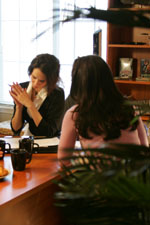Decorating Your Restaurant's Interior
You already know that your restaurant’s interior design is one of the most essential aspects of your business’s presentation. But you didn’t dive into this industry because of your interior design skills. Most people leave the design of their restaurant up to an independent firm or adopt the design of a previous ownership. But you have to have some control over the appearance of your building. Interior design principles are the primary statement your building makes to many people. The look and feel of your business is captured by the design of your dining room. It is the first thing most people notice when they enter your restaurant. Therefore, you must find a design firm or independent contractor who knows what they are doing, and is willing to work with you to execute your vision. Unfortunately, a basic tenet of interior design is that it is always more expensive than it should be. A second basic rule is that it is inherently painful to pour start-up capital into your building’s appearance without having earned a dollar yet. You know the building has to look right. But how to maximize attractiveness while sticking to a budget? The answer is probably that you can’t, but follow a few basic rules to get as close as possible.
Shop Around
You’ve shopped around for everything else—vendors, maintenance, HVAC, employees. Why not work to find the right interior design company? Sure, it’s common sense. But shopping around means asking other operators who they use, working the phones and counter-offering until you find the right company. This is especially true if you are entering a brand new building. Retro-fitting a pre-existing building is a little easier. If capital is an issue (as it always is), it can be worth it to plan for a minimal open appearance, and add design accoutrements along the way. Also, be prepared to miss something essential and have the resources to fix it quickly. A restaurant I know of once opened without blinds on a wall-length row of vaulted window, blinding any guest facing that direction during the early evening hours (of which roughly a third were). Rest assured that had to be addressed pretty quickly.
Have a Discernible Theme
A discernible theme that ties in with the name or cuisine (or both) of a restaurant is a great way to spread your company’s brand/identity. A theme should be present enough to be noticeable. However, the days of cramming a theme down a guest’s throat have (thankfully) disappeared. Discernible themes that have value without overwhelming the guest can be present in any or all of the following:
- Paint schemes
- Artifacts/keepsakes
- Pictures/wall decorations
- Trim/woodworking
- Architectural design
- Lighting
- Naming of rooms/tables
Finding a way to convey your theme with subtlety can be easier said than done. I knew of a restaurant that was designed in such a way as to evoke a different season with each of its four dining rooms. The only problems was that few, if any, guests noticed the theme. On the other hand, it’s hard to miss the theme at a Hard Rock Café or Rain Forest Café franchise. And it’s also hard to miss the theme at Chuck E. Cheese. Leave the flair to T.G.I. Friday’s and decorate your restaurant with a theme that is recognizable, but remains in the background.
Be True to Yourself
It’s worth it to consider the clientele you are coveting. For example, a restaurant that is working to attract female clientele will be more likely to have soft lighting and bright colors. A chophouse built as a male haunt might incorporate dark mahogany and brass trim. The cuisine can also be a factor. Seafood restaurants might be washed in teal or blue, while an Italian restaurant might have relics from the Mediterranean.
Let the Experts Handle it
Maybe you can decide between sconces or insets behind the bar. Or you know whether to use banquettes or booths, with chandeliers or hatbox lights over them. But most restaurant operators don’t. It’s important to hire a solid architectural design firm for your front-of-the-house, just as it is for your kitchen. Then give them your vision, oversee the project, and get out of the way.
